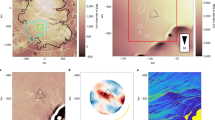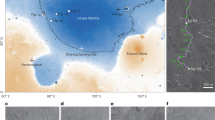Abstract
In addition to measuring ice-sheet thickness, ground-penetrating radar can be used to delineate reflections in ice sheets1,2,3. These reflections are generally accepted to result from layers of isochronous deposition of snow and can reveal much about the dynamics of the ice flow. Here we present ground-penetrating radar data from Fletcher Promontory, Antarctica, which show arches and troughs in isochronous ice layers to a depth of 100 m. We demonstrate that the origin of these features can be determined by their growth with depth, and many features result from local anomalies in accumulation rate which can be correlated with the ice surface slope. One arch appears to be the result of a local anomaly in vertical strain-rate. Its proximity to the ice divide, width, and growth with depth, indicate that this arch is one of a class of features postulated by Raymond4 but not previously shown to exist in the field. Such a feature is an indication of the nonlinear rheology of ice and requires that palaeoclimate records from ice cores extracted from the vicinity of ice divides underlain by similar features should be specifically corrected for such effects on ice-flow.
This is a preview of subscription content, access via your institution
Access options
Subscribe to this journal
Receive 51 print issues and online access
$199.00 per year
only $3.90 per issue
Buy this article
- Purchase on Springer Link
- Instant access to full article PDF
Prices may be subject to local taxes which are calculated during checkout





Similar content being viewed by others
References
Robin, G. deQ. The Climatic Record in Polar Ice Sheets(Cambridge Univ. Press, (1983).
Clarke, T. S. & Bentley, C. R. High-resolution radar on Ice Stream B2, Antarctica: measurements of electromagnetic wave speed in firn and strain history from buried crevasses. Ann. Glaciol. 20, 153–159 (1994).
Kohler, J., Moore, J., Kenet, M., Engeset, R. & Elvehøy, H. Using ground-penetrating radar to image previous year's summer surfaces for mass balance measurements. Ann. Glaciol. 24, 255–260 (1997).
Raymond, C. F. Deformation in the vicinity of ice divides. J. Glaciol. 29, 357–373 (1983).
Frolich, R. M. & Doake, C. S. M. SAR interferometry over Rutford Ice Stream and Carlson Inlet, Antarctica. J. Glaciol. 44, 77–92 (1998).
Paren, J. G. & Robin, G. deQ. Internal reflections in polar ice sheets. J. Glaciol. 14, 251– 259 (1975).
Miners, W. D. et al. Forward modelling of the internal layers in radio echo sounding using electrical and density measurements from ice cores. J. Phys. Chem. B 101, 6201–6204 ( 1997).
Harrison, C. H. Radio echo sounding of horizontal layers in ice. J. Glaciol. 12, 383–397 (1973).
Black, H. P. & Budd, W. Accumulation in the region of Wilkes Land, Antarctica. J. Glaciol. 5, 3– 15 (1964).
Whillans, I. M. Effect of inversion winds on topographic detail and mass balance on inland ice sheets. J. Glaciol. 14, 85– 90 (1975).
Thomas, R. H., Stephenson, S. N., Bindschadler, R. A., Shabtaie, S. & Bentley, C. R. Thinning and grounding line retreat on the Ross Ice Shelf, Antarctica. Ann. Glaciol. 11 , 165–172 (1988).
Vaughan, D. G. Relating the occurrence of crevasses to surface strain rates. J. Glaciol. 39, 255–267 (1993).
Dahl-Jensen, D. Two-dimensional thermo-mechanical modelling of flow and depth-age profiles near the ice divide in Central Greenland. Ann. Glaciol. 12, 31–36 (1989).
Schøtt Hvidberg, C. Steady-state thermomechanical modelling of ice flow near the centre of large ice sheets with the finite-element technique. Ann. Glaciol. 23, 116–123 (1996).
Weertman, J. Sliding-no sliding zone effect and age determination of ice cores. Quat. Res. 6, 203–207 ( 1976).
Sandhäger, H. Review of the Münster Airborne Radio-echo Sounding-data Set: Marine Ice beneath Filchner-Schelfeis; Bottom Reflectivity and Internal Structures of Berkner Island 111–114 (Filchner-Ronne Ice Shelf Programe Rep. No. 9, Alfred-Wegener Inst., Bremerhaven, ( 1996).
Steinhage, D. & Blindow, N. Results of Short Pulse Radio Echo Sounding on Thyssenhöhe, Berkner Island, Antarctica 106– 109 (Filchner-Ronne Ice Shelf Programme Rep. No. 10, Alfred-Wegener Inst. Bremerhaven, (1997).
Raymond, C. F. et al. Geometry and stratigraphy of Siple Dome, Antarctica. Antarct. J. US 30, 91–93 (1995).
Nereson, N. A., Raymond, C. F., Waddington, E. D. & Jacobel, R. W. Recent migration of the Siple Dome ice divide, West Antarctica. J. Glaciol. 44, 643–652 (1998).
Schøtt, C., Waddington, E. D. & Raymond, C. F. Predicted time-scales for GISP2 and GRIP boreholes at Summit, Greenland. J. Glaciol. 38, 162 –168 (1992).
Hempel, L. & Thyssen, F. Deep radio echo soundings in the vicinity of GRIP and GISP2 drill sites, Greenland. Polarforschung 62, 11–16 ( 1992).
Jacobel, R. W. & Hodge, S. M. Radar internal layers from the Greenland summit. Geophys Res. Lett. 22, 587–590 (1995).
Fisher, D. A. et al. Effect of wind scouring on climatic records from ice-core oxygen-isotope profiles. Nature 301, 205 –209 (1983).
Doake, C. S. M. & Wolff, W. W. Flow law for ice in polar ice sheets. Nature 314, 255 –257 (1985).
Wolff, E. W. & Doake, C. S. M. Implications of the form of the flow law for a vertical velocity and age-depth profiles in polar ice. J. Glaciol. 32, 366–370 (1986).
Frolich, R. M., Vaughan, D. G. & Doake, C. S. M. Flow of Rutford Ice Stream and comparison to Carlson Inlet, Antarctica. Ann. Glaciol. 12, 51– 56 (1989).
Paterson, W. S. B. The Physics of Glaciers3rd edn (Elsevier Science, Oxford, ( 1994).
Acknowledgements
We thank C. Raymond, R. C. A. Hindmarsh, N. Nereson and colleagues at the British Antarctic Survey for their help and comments.
Author information
Authors and Affiliations
Corresponding author
Rights and permissions
About this article
Cite this article
Vaughan, D., Corr, H., Doake, C. et al. Distortion of isochronous layers in ice revealed by ground-penetrating radar. Nature 398, 323–326 (1999). https://doi.org/10.1038/18653
Received:
Accepted:
Issue Date:
DOI: https://doi.org/10.1038/18653
This article is cited by
-
Internal layering structure and subglacial conditions along a traverse line from Zhongshan Station to Dome A, East Antarctica, revealed by ground-based radar sounding
Applied Geophysics (2020)
-
Pros and Cons in Helicopter-Borne GPR Data Acquisition on Rugged Mountainous Areas: Critical Analysis and Practical Guidelines
Pure and Applied Geophysics (2019)
-
Structure of the internal isochronous layers at Dome A, East Antarctica
Science China Earth Sciences (2011)
-
Mapping vertical profile of discontinuous permafrost with ground penetrating radar at Nalaikh depression, Mongolia
Environmental Geology (2009)
Comments
By submitting a comment you agree to abide by our Terms and Community Guidelines. If you find something abusive or that does not comply with our terms or guidelines please flag it as inappropriate.



